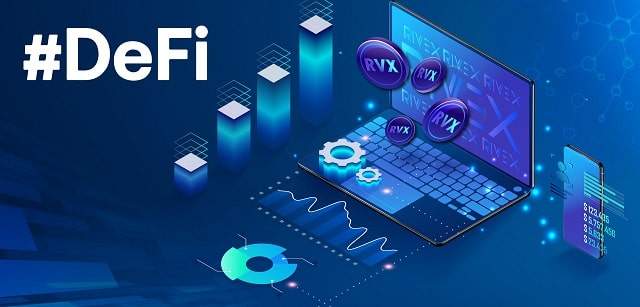What is Decentralized finance or DeFi, in this guide you will get detailed knowledge about DeFi and new paradigm of finance with cryptocurrencies.
Emerging in the world of finance is a new technology known as decentralized finance (DeFi), which is built on top of encrypted distributed ledgers just like those utilized by cryptocurrencies.
The Federal Reserve and the Securities and Exchange Commission (SEC) in the United States are responsible for defining the rules that apply to centralized financial institutions such as banks and brokerages. Consumers rely on these institutions to access capital and financial services directly.
Individuals are given more power within DeFi’s peer-to-peer digital exchanges, which challenges the current centralized financial system.
What is DeFi
The term “decentralized finance” (abbreviated as “DeFi”) refers to an ecosystem of financial applications that contests the notion that centralized governing bodies should have control over financial services.
It is a worldwide movement toward decentralization to establish open-source, transparent, and consentless financial service systems accessible to anyone worldwide without the requirement of centralized oversight or authority. This is the goal of the global decentralization movement.
- DeFi applications and services are built using public blockchains such as Ethereum.
- They can reproduce the centralized financial services that are already in existence, and they can even offer new and innovative services that have been developed with DeFi systems in mind.
- DeFi does away with the fees that traditional financial institutions such as banks and other financial corporations charge customers for the use of their services.
- DeFi allows users to store their money in a safe and encrypted digital wallet (eg: frontier wallet) and transfer funds in a matter of minutes. It is accessible to anyone who has access to the internet.
- By empowering individuals, merchants, and enterprises with the ability to execute financial transactions using developing technology, decentralized finance removes the need for middlemen in the financial system.
- DeFi is an abbreviation for decentralized finance, and it refers to the use of peer-to-peer financial networks that utilize improvements in security protocols, connectivity, software, and hardware.
Individuals can lend, trade, and borrow money using software that records and validates financial acts in distributed financial databases. These activities may take place everywhere there is an internet connection. A distributed database may be accessed from several places because it gathers and aggregates data from all users and then utilizes a consensus technique to validate the data.
It is no longer necessary to use a centralized model of finance because decentralized finance makes it possible for anyone, regardless of who they are or where they are, to use financial services anywhere. Through the use of personal wallets and trade services geared specifically at people, DeFi apps enable users to exert a greater degree of control over their monetary holdings.
What are DeFi and Smart Contracts?
Self-executing contracts are referred to as smart contracts. This kind of contract has the terms of the agreement between the buyer and seller encoded straight into lines of code. Once it has been generated, this code and agreement cannot be changed, but they are still viewable on public blockchains like Ethereum.
Everyone can access them and check the smart contract; moreover, transactions can never be reversed and are always traceable. The concept of “smart contracts” is essential to operating decentralized financial systems. They encrypt the particular terms, agreements, and actions of the many distributed apps (DApps). These schemes include more than simply transferring money back and forth.
One such illustration of this would be the giving of a loan by one party to another. The specifics of the loan would be encoded into smart contracts, and once those contracts were created, no changes could be made to them. It may be necessary to sell the borrower’s collateral if certain requirements are not satisfied by the borrower. Instead of third-party organizations like banks being responsible for enforcing these agreements, the coding behind smart contracts is responsible for doing so.
What is Lending and Borrowing?
You could consider depositing money into a savings account in conventional banking systems, where you can earn an interest rate of 0.5 percent on your savings. Afterward, the bank can lend that money to another client at an interest rate of 3%, keep 2.5% of the rate for themselves, and leave 0.5% interest for the savings account owner.
Users of DeFi have the ability to lend investments directly to other users, eliminating the need for a third party and allowing them to keep the full three percent interest return on their funds. You can put your cryptocurrency into borrowing and lending DApps like Compound and Aave so that it may be used as collateral and for you to borrow against it. You can also deposit your cryptocurrency to lend it out and earn interest or passive income on your investment.
Smart contracts are used to accomplish the goals of ensuring the safety of the money, automatically matching borrowers and lenders, and dynamically adjusting interest rates in response to fluctuations in supply and demand.
What are Liquidity Pools?
Participants in this industry have had access to a new method of trading/swapping crypto assets without using CEX platforms since the latest DeFi run. Decentralized trading startups like Uniswap and Sushiswap use an automated market maker (AMM) method to match orders for their traders, in contrast to traditional exchanges like Binance, Coinbase, FTX, etc.
On DEXs and AMMs, LPs provide token pairs in equal quantities via liquidity pools (basically smart contracts) such as ETH/USDC. This served as the foundation for modern DeFi. Liquidity providers (LPs) take a cut of the fees paid by DEX and AMM users in exchange for the ease with which they may trade tokens on the DEX and AMM. Funding limited partners in a Uniswap pool allows them to collect a cool 0.30% of the swap fees for that pool. For Crypto & DeFi enthusiasts, the swap fees earned by various DEXs like Sushiswap, dY/dX, Paraswap, Shibaswap, Quickswap, Plasmaswap, etc. provide an intriguing passive income opportunity.
What is Yield Farming?
We discussed how liquidity provision is a great method to make passive income in crypto, particularly in the DeFi industry. While LPs may make money from swap fees for providing liquidity on DEXs and AMMs, they also stand to profit from the governance tokens used by these platforms. Decentralized exchanges (DEXs) and autonomous multilateral markets (AMMs) are distinct from centralized exchanges because their operations are managed by decentralized entities utilizing governance tokens. Providing DEXs and AMMs with liquidity in their governance tokens so that they may generate fees and more governance tokens is an example of “yield farming.”
In another sense, LP tokens are derivative tokens representing an LP’s portion of the liquidity pool. They are offered in return for LPs depositing cash (often in stablecoins like DAI, USDC, USDT, etc.). These LP tokens may be staked on other DeFi protocols like lending and are stored in non-custodial wallets like Frontier (others include Trust, Argent, Metamask, etc.). As a result, LPs may increase their income by farming both their current crypto assets and brand-new LP tokens.


